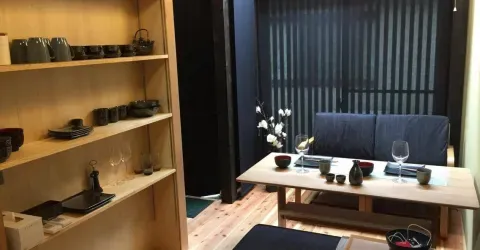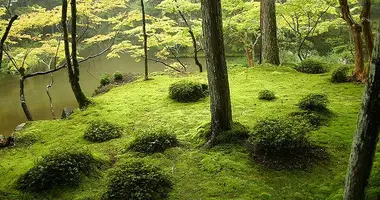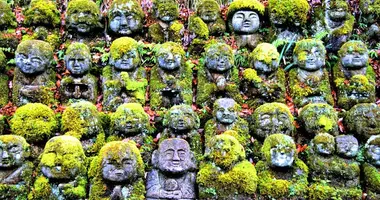Ryozen Kannon Temple: A unique war memorial in Kyoto's Gion district

Ryozen Kannon, Kyoto, Japan
Nestled in the heart of Kyoto's historic Gion district, the Ryozen Kannon Temple stands as a striking testament to peace and remembrance. This unique Buddhist temple, established in 1955, serves as a solemn memorial to those who lost their lives during the Pacific War. With its towering 24-meter concrete statue of Kannon, the Goddess of Mercy, overlooking the grounds, Ryozen Kannon offers visitors a profound space for reflection and contemplation. Unlike many traditional Japanese temples, this site blends elements of Buddhist architecture with modern design, creating a distinctive atmosphere that sets it apart from other religious landmarks in Kyoto. As we explore the history, features, and significance of Ryozen Kannon Temple, we'll uncover how this memorial has become an important symbol of reconciliation and a poignant reminder of the costs of conflict.
History and significance of Ryozen Kannon Temple
The Ryozen Kannon Temple was founded in 1955 by Hirosuke Ishikawa, a successful Japanese entrepreneur. Its establishment came just ten years after the end of World War II, at a time when the memories of the conflict were still fresh in the minds of many Japanese citizens. The temple was conceived as a Buddhist alternative to the controversial Yasukuni Shrine in Tokyo, which has been a source of tension due to its enshrinement of convicted war criminals alongside other war dead.
What sets Ryozen Kannon apart is its dedication to honoring all victims of the Pacific War, regardless of nationality. This inclusive approach to memorialization was groundbreaking for its time and remains a unique aspect of the temple today. The site contains memorials not only for Japanese soldiers and civilians but also for Allied prisoners of war who perished under Japanese control during the conflict.
The temple's location in Kyoto, the former imperial capital of Japan, is also significant. Situated near the Maruyama Koen and Yasaka Jinja, Ryozen Kannon became an integral part of Kyoto's religious and cultural landscape. Its presence in this historic area serves as a reminder of Japan's journey from wartime to peacetime, and its role in fostering international understanding and reconciliation.
Architecture and key features of the temple complex
The most striking feature of Ryozen Kannon Temple is undoubtedly the 24-meter tall concrete statue of Kannon, the Goddess of Mercy. This imposing figure, visible from many parts of eastern Kyoto, was designed to be a symbol of peace and compassion. The statue's design is based on a 13th-century painting of Kannon held at Kyoto's Daitoku-ji temple and was the last work of renowned sculptor Yamazaki Chōun.
Visitors to the temple can enter the body of the statue to see an enshrined Eleven-headed image of Kannon. This unique feature allows for a more intimate experience with the deity and provides a space for personal reflection. The interior of the statue also houses shrines dedicated to the different signs of the zodiac, adding another layer of spiritual significance to the structure.
The temple grounds include several other notable features:
- A large reflecting pool in front of the Kannon statue, which hosts lotus blossoms in summer
- A main hall that serves as a space for services and gatherings
- The Reihaiden, a hall containing 600,000 small Buddhist tablets (ihai) for those who died in the Asia-Pacific War
- A Memorial Hall built in 1959 to house a monument to the unknown soldier
- A Christian-style chapel in the northeast of the grounds, containing records of Allied soldiers and prisoners of war
The architectural style of Ryozen Kannon blends traditional Buddhist elements with modern design, creating a unique aesthetic that reflects its post-war origins and its mission of bridging cultural and national divides.

The concrete statue of the Goddess of Mercy, Ryozen Kannon, Kyoto
Memorials and tributes within the temple grounds
Ryozen Kannon Temple houses several significant memorials and tributes that make it a unique site of remembrance in Japan. These include:
1. A register containing the names of two million Japanese war dead. This comprehensive list serves as a poignant reminder of the scale of loss during the Pacific War.
2. The Reihaiden Hall, which contains 600,000 small Buddhist tablets (ihai) for Japanese and others who died in the Asia-Pacific War. Notably, this includes tablets for Korean victims, acknowledging the complex history of Japan's colonial past.
3. A monument to the unknown soldier in the Memorial Hall. This tribute recognizes those whose identities were lost in the conflict, echoing similar memorials around the world.
4. Vessels of soil from war cemeteries around the world. This collection symbolizes the global nature of the conflict and serves as a physical connection to battlefields across the Pacific.
5. Cabinets containing records of tens of thousands of Allied POWs who died in Japanese captivity between 1941 and 1945. These records are not only a memorial but also a valuable historical resource.
6. An altar containing soil from every Allied cemetery from the Pacific theater of World War II. This feature underscores the temple's commitment to honoring all victims of the war, regardless of nationality.
These memorials collectively make Ryozen Kannon a site of transnational memory, bridging divides between former enemies and offering a space for shared mourning and reconciliation.

Individual names of Allied personnel who perished under Japanese jurisdiction during World War II, Ryozen Kannon
Spiritual practices and rituals at Ryozen Kannon
Ryozen Kannon Temple offers a unique blend of Buddhist practices and modern memorial rituals. Some of the key spiritual activities at the temple include:
1. Incense offering: Visitors are given a stick of incense upon entry, which they can light and place in a large pot near the reflecting pool. This act is seen as a way to pay respects to the deceased and purify the surroundings.
2. Prayer at the Kannon statue: Visitors can enter the statue and pray before the enshrined Eleven-headed image of Kannon (the Goddess of Mercy). This practice is believed to bring blessings and compassion.
3. Zodiac prayers: Inside the Kannon statue, there are symbols of guardian angels for each of the twelve zodiac signs. Visitors are encouraged to offer prayers before the guardian angel corresponding to their birth year.
4. Wishing ritual: The temple features a curious golden ball called the "Wishing Precious Stone." Visitors can place their right hand on the ball, walk around it three times, and then write their wish on a paper disc to hang with others.
5. Memorial services: Four times a day, services are conducted in memory of the war dead. These services are performed by monks from various Buddhist sects, reflecting the temple's non-denominational approach.
6. Mizuko kuyō: The temple offers rituals for the spirits of unborn children (mizuko), providing a space for parents to mourn and pray for these souls.
These practices reflect Ryozen Kannon's role as both a war memorial and a living spiritual site, offering visitors various ways to engage with its themes of peace, remembrance, and compassion.
Visiting Ryozen Kannon: Practical information and tips
For those planning a visit to Ryozen Kannon Temple, here's some essential information:
Location: The temple is located at 526-2 Shimokawahara-cho, Higashiyama-ku, Kyoto 605-0825.
Access: Ryozen Kannon is a 10-15 minute walk from Shijo Keihan Station. From Kyoto Station, take bus #206 or #207 to the Gion bus stop and walk up the hill.
Opening hours: The temple is open from 8:40 AM to 4:20 PM daily. (Note that the reception closes at 4:00 PM)
Admission fee: 300 yen for adults and university students (includes incense sticks), 200 yen for junior high and high school students, and 100 yen for elementary school children.
Tips for visitors:
- Allow at least an hour to fully explore the temple grounds and its memorials.
- Consider visiting early in the day to avoid crowds, especially during peak tourist seasons.
- Dress respectfully, as this is both a religious site and a war memorial.
- Take time to reflect at the various memorials and participate in the spiritual practices if you wish.
- Photography is generally allowed, but be respectful, especially in areas dedicated to memorialization.
- Consider combining your visit with trips to nearby attractions in the Higashiyama district.
Remember, Ryozen Kannon is not just a tourist site but a place of remembrance and reflection. Approach your visit with respect and an open mind to fully appreciate its significance.

Stained glass in a memorial chapel, Ryozen Kannon
Surrounding attractions and nearby points of interest
Ryozen Kannon Temple is located in the heart of Kyoto's historic Higashiyama district, making it easy to combine a visit with other nearby attractions. Here are some points of interest in the vicinity:
1. Maruyama Koen: This beautiful public park is just a short walk from Ryozen Kannon. It's especially popular during cherry blossom season but offers a peaceful retreat year-round.
2. Yasaka Jinja: Also known as Gion Shrine, this important Shinto shrine is one of Kyoto's most famous landmarks and is particularly atmospheric in the evening when its lanterns are lit.
3. Chionin: This impressive temple is the headquarters of the Jōdo sect of Japanese Buddhism and features Japan's largest temple bell.
4. Shoren-in: A serene temple known for its beautiful gardens and nighttime illuminations.
5. Ryozen Museum of History: This small museum focuses on the final days of the Tokugawa shogunate and the Meiji Restoration.
6. Kodaiji Temple: A Zen temple famous for its rock gardens and bamboo grove.
7. Gion: Kyoto's famous geisha district is nearby, offering a glimpse into traditional Japanese entertainment culture.
8. Kiyomizudera: One of Kyoto's most famous temples, known for its wooden terrace offering panoramic views of the city.
9. Okazaki museum district: A 20-minute stroll north will take you to this area, home to several museums and cultural institutions.
10. Heian Shrine: Notable for its large torii gate and beautiful gardens, this shrine is also about a 20-minute walk from Ryozen Kannon.
Visitors interested in exploring more of Kyoto's rich history and culture might consider purchasing one of the many available Books on Kyoto Japan for deeper insights into the city's attractions.
With its central location in the Higashiyama district, Ryozen Kannon serves as an excellent starting point or stop on a tour of Kyoto's eastern sightseeing circuit. Its unique blend of modern memorial and traditional Buddhist temple provides a thought-provoking contrast to the ancient shrines and temples that surround it, offering visitors a comprehensive view of Japan's complex religious and historical landscape.





























